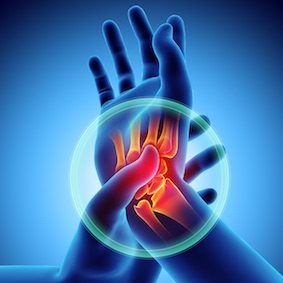What is wrist pain?
Wrist pain is connected to a wrist injury. A wrist injury usually occurs after a traumatic incident such as a fall onto an outstretched hand. This can cause stretching to the ligaments and the capsule around the wrist and sometimes even lead to a tear. It can even cause damage to the cartilage and ligaments within the wrist. A swelling occurs with possible bruising as well which can cause compression pain in and around the wrist and decreased movement of the wrist joint. Wrist pain can also be the result of an overstrain injury. Soft tissue such as muscles, tendons and ligaments become chronically irritated. The strain injury is caused by difficult, repetitive or (overly) intense activities, work or exercises. Subsequently, mobility in the wrist joint is restricted and painful.
Wrist pain symptoms
After the trauma has occurred, wrist injury symptoms may include:
- Pain (resulting from pressure) and a feeling of warmth near the wrist joint.
- Restricted wrist mobility
- Swelling around the wrist
- Discolouration around the wrist
Symptoms of a repetitive strain injury of the wrist are:
- Wrist pain occurring at the beginning, during or after a particular action
- Pain when bending or stretching the wrist
- Pain after lengthy activity
- Pain when performing against resistance or lifting heavy objects
- Swelling and possibly a feeling of warmth and redness
Wrist pain prevalence and who it affects
Two out of every three wrist injuries are caused by a fall. In the Netherlands, around 100,000 people yearly develop wrist injuries. Four out of five cases are acute wrist injuries. Young athletes are most susceptible but older people can sustain wrist injuries because of falls too.
Risk factors
Falling is one of the main causes for acute wrist injuries. Types of sport that are most likely to lead to a wrist injury are football, rugby, hockey, boxing, Physical Education, gymnastics, skiing, snowboarding and skating. Repetitive strain movements of the wrist during hazardous work and unusually heavy activities (such as moving, DIY, etc) can gradually develop into a wrist injury.
Self-help for wrist injuries
When trauma causes wrist injury, it is recommended to immediately treat it with the ICE-method: ICE = Apply cold water, ice or a cold pack to the joint for about 15 to 20 minutes. Use a piece of cloth between the skin and the ice or the cold pack to avoid any ice burns. Repeat four or five times a day for the first two days.
I= Immobilise: keep the wrist still. Wear a wrist brace or tape during exercise and if necessary, during the day as well. This will give the tendons and ligaments the opportunity to recover.
C = Compression: Wrap the affected area with an elastic/compression bandage
E = Elevation: Regularly elevate your wrist above the level of your heart.
If the symptoms haven’t eased after a couple of days, it is advisable to go and see a physiotherapist, a doctor or GP.
Ways to prevent wrist injury:
- Avoid repetitive movements
- Take plenty of rest in between heavy, repetitive activities
- Avoid pressure at work, stress and fatigue
- Incorporate adequate warm-up and cool-down sessions in your exercise routine
- Gradually build up your exercise program so your body can adjust to heavier loading
- Don’t do push ups with your palms flat on the floor; this can aggravate your wrist pain. Keep your wrists fully extended and fold your hands into fists or use hand-support
- For high risk sports such as squash, you can use tape on your wrists to add some extra support for the ligaments.
- Wear protective gear during high risk sports such as inline skating, and make sure to use good quality equipment such as a tennis or squash racket with a suitable grip

Physiotherapy treatment for wrist pain
During the first stage, immediately after you have sustained your wrist injury, a physiotherapist can advise what the best way is for you to use your hand and wrist. He can also improve the oedema (swelling) and takes care that your wrist’s load bearing capacity isn’t compromised. After one or two weeks – when the swelling has gone down – you can start your rehabilitation therapy. You will be given exercises that will improve mobility, coordination and muscle strength in your wrists. A physiotherapist can also advise you on pain relief, how to use your wrist/hand and how to prevent recurring problems.
Which other physical complaints does FysioCity treats?
Book an appointment
 NL
NL